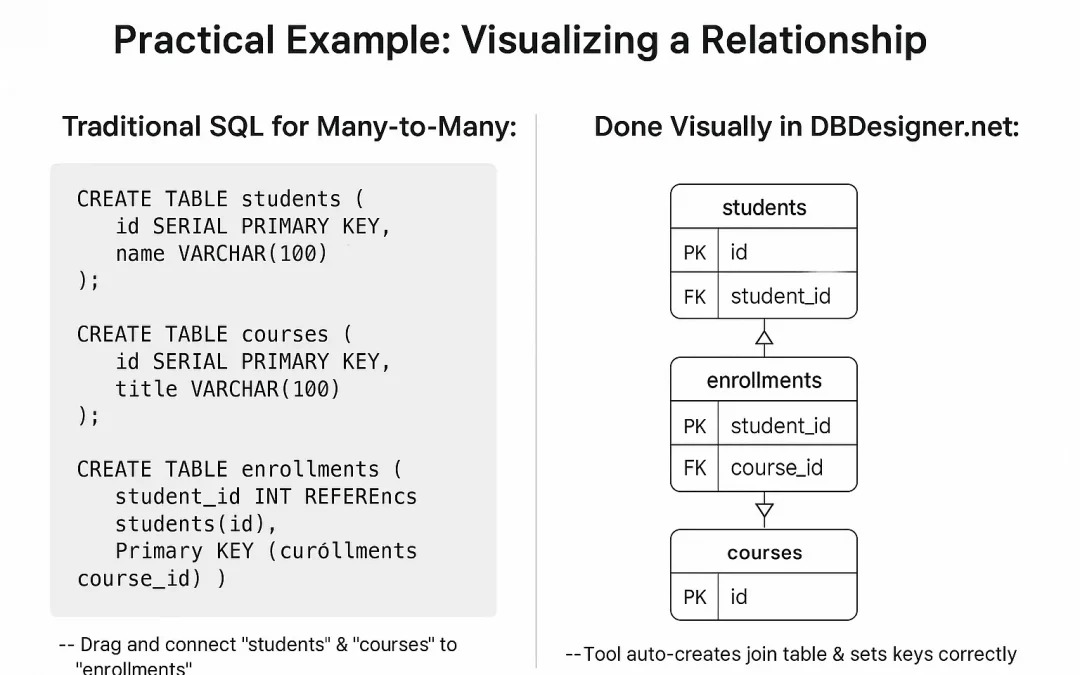Mastering Database Relationships for Scalable Design
Well-structured relationships are the backbone of every robust database. With DBDesigner’s visual modeling, you can easily map, manage, and optimize one-to-one, one-to-many, and many-to-many relationships—all without writing manual SQL.
“A database with well-defined relationships is 4x easier to evolve and scale in production environments.” – 2024 Cloud Data Architecture Report
Why Relationships Drive Data Quality
- Data Integrity: Enforce valid connections between tables
- Redundancy Reduction: Store data once, reference everywhere
- Query Simplification: Easily retrieve related data
- Automatic ERD Generation: Visualize relationships instantly in DBDesigner
Types of Database Relationships Explained
With visual schema design, you can create and modify these relationship types:
- One-to-One (1:1): Each row in Table A links to one row in Table B
- One-to-Many (1:N): One record relates to multiple in another table (e.g., Customer → Orders)
- Many-to-Many (N:M): Multiple records relate to multiple (e.g., Students → Courses via Enrollment table)
Practical Example: Visualizing a Relationship
Traditional SQL for Many-to-Many:
CREATE TABLE students ( id SERIAL PRIMARY KEY, name VARCHAR(100) );
CREATE TABLE courses ( id SERIAL PRIMARY KEY, title VARCHAR(100) );
CREATE TABLE enrollments ( student_id INT REFERENCES students(id), course_id INT REFERENCES courses(id), PRIMARY KEY (student_id, course_id) );Done Visually in DBDesigner:
-- Drag and connect "students" & "courses" to "enrollments" -- Tool auto-creates join table & sets keys correctly Relationship Benefits
- Zero orphan records (enforced by foreign keys)
- Cleaner reports with JOINs auto-suggested
- Instant updates when schema evolves
Advanced Relationship Features
- Cascading Actions: Auto-update/delete linked records with ON UPDATE/DELETE CASCADE
- Optionality: Designate required vs. optional relationships visually
- Polymorphic Relationships: Model flexible references for modern app needs
- Team Collaboration: Share live relationship diagrams in real time
Best Practices for Relationship Design
Planning
- Start with a clear ERD (entity relationship diagram)
- Identify all business entities and connections
Consistency
- Name foreign keys clearly (e.g.,
customer_id) - Use standard naming for join tables (
enrollments,user_roles)
Review
- Regularly audit for unused or broken relationships
- Document all relationship rules for your team
Conclusion: Design Relationships for Success
Modern teams that prioritize relationship modeling see benefits in:
- Scalability & maintainability of their databases
- Data accuracy and fewer bugs
- Rapid onboarding for new team members
Ready to Build Smarter Schemas? Design Relationships Visually Now (No coding needed, instant ERDs)
For Enterprise Teams:
Collaborate on complex relationship modeling in real time


Recent Comments